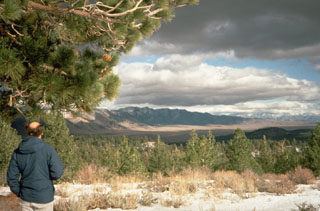Report on Long Valley (United States) — October 1982
Scientific Event Alert Network Bulletin, vol. 7, no. 10 (October 1982)
Managing Editor: Lindsay McClelland.
Long Valley (United States) More earthquake swarms
Please cite this report as:
Global Volcanism Program, 1982. Report on Long Valley (United States) (McClelland, L., ed.). Scientific Event Alert Network Bulletin, 7:10. Smithsonian Institution. https://doi.org/10.5479/si.GVP.SEAN198210-323822
Long Valley
United States
37.7°N, 118.87°W; summit elev. 3390 m
All times are local (unless otherwise noted)
Occasional earthquake swarms have been located in the S side of the caldera, but the region that had been most active seismically has remained quiet since the swarm of 7-8 May. The earthquake swarms since 7-8 May have not included spasmodic tremor. Hypocenters for the swarms have typically been restricted to pipe-like zones. The typical swarm pattern has begun with a burst of deep events, followed by a shallow burst, then a series of events beneath the two.
On 19 September, 40-50 events occurred at depths of 3-6.5 km along an intracaldera branch of the Hilton Creek Fault, on the edge of the resurgent dome about 4 km NE of Casa Diablo Hot Springs (figure 1). The largest event , M 3.2, occurred well after the beginning of the swarm. Roughly 9 km to the WSW, a swarm of more than 100 shocks started 18 October. Most of the events occurred the first day, but a few continued through 24 October. All ranged from 3.5-6.5 km depth (most 5-6 km) and the maximum magnitude was 2.5. On 3 November at 0945, a swarm of more than 100 events began near a thermal area about 2.5 km N of the 19 September epicenters. Depths ranged from roughly 3.5-10 km and the maximum magnitude was 2.9. Only very small events were recorded after 2113.
Geological Summary. The large 17 x 32 km Long Valley caldera east of the central Sierra Nevada Range formed as a result of the voluminous Bishop Tuff eruption about 760,000 years ago. Resurgent doming in the central part of the caldera occurred shortly afterwards, followed by rhyolitic eruptions from the caldera moat and the eruption of rhyodacite from outer ring fracture vents, ending about 50,000 years ago. During early resurgent doming the caldera was filled with a large lake that left strandlines on the caldera walls and the resurgent dome island; the lake eventually drained through the Owens River Gorge. The caldera remains thermally active, with many hot springs and fumaroles, and has had significant deformation, seismicity, and other unrest in recent years. The late-Pleistocene to Holocene Inyo Craters cut the NW topographic rim of the caldera, and along with Mammoth Mountain on the SW topographic rim, are west of the structural caldera and are chemically and tectonically distinct from the Long Valley magmatic system.
Information Contacts: R. Bailey, USGS, Reston, VA; R. Cockerham, USGS, Menlo Park, CA; A. Ryall, University of Nevada, Reno.

